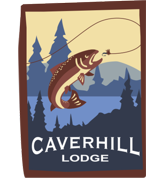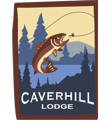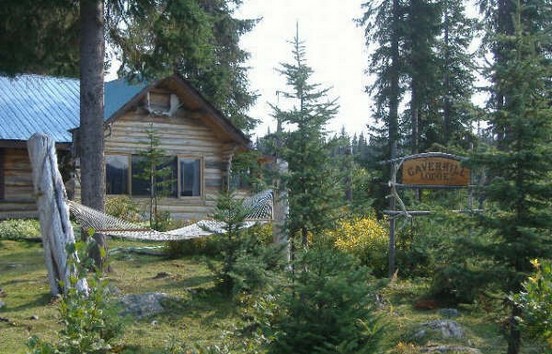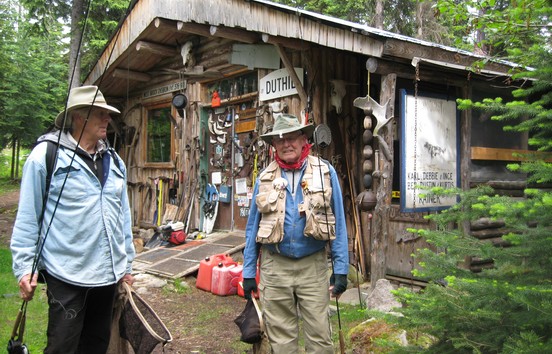FLY SELECTION FOR THE CAVERHILL LAKE AREA
by Brian Chan
During your fishing trip at Caverhill, you will learn the numerous small lakes within the Caverhill lake chain support diverse populations of invertebrates and aquatic insects that are all prime trout food sources. Cool, well oxygenated water and abundant shallow areas within these lakes provide ideal habitat for these food sources as well as prime feeding areas for the trout.
Leeches are one of the most important food sources for trout in these lakes. The most common leech colours are black, dark brown, mottled green and brown and maroon. Fly patterns such as the Little Fort Leech, Maroon Ruby-eyed Leech, Black Rabbit Strip Leech and basic Woolly Buggers in various colour combinations are all effective patterns. Bead-headed patterns provide more weight to the fly and will allow it to undulate more naturally during a retrieve or while trolled. Patterns in sizes #10-3X to #6-3X will cover the natural size range of leeches in these waters.
Midges or chironomids are another significant trout food source. Fish will feed on the larval, pupal and adult life stages of these insects. Maroon or red coloured bloodworm patterns are excellent imitations of the larval stage of these insects. Try bloodworm patterns tied on #14-2X and #12-2X hooks. Chironomid larvae should be fished within inches of the bottom of the shoal. The easiest way to present them is suspended under strike indicators.
Chironomid pupa come in a wide variety of colours but the most common species are black, green or brown. At this elevation the most intense pupal emergences occur from late June through August, but smaller hatches occur throughout the entire open water season. The best pupal patterns should be in the following body and rib colours; black with red wire rib, black with silver wire rib, green with gold wire rib and brown with natural copper wire rib. Pupal patterns tied on shrimp/pupa hooks in sizes #14 to #12 will best imitate the real chironomid pupa in these lakes. Try patterns with white, gold or black metal bead heads as they add weight and flash to the flies. As with the chironomid larvae, the pupa are often best fished while suspended under a strike indicator. Set the indicator so that the pupal pattern is within about 12 inches of the lake bottom in water from 6 to 16 feet in depth. Rainbow also love to eat the newly emerged adult chironomid or egg-laying females. The Lady McConnell, Griffiths Gnat and small, black bodied Humpy’s in sizes #14 and # 16 should be included in your box of flies.
Callibaetis mayflies are found in all the lakes of the Caverhill area. Trout feed on both the nymph and adult stages of these insects. Ideal habitat for the nymphs are the patches of emergent vegetation or the rocky bottom areas that cover the shallow or shoal zones of these lakes. Mayfly hatches often begin occurring by mid-June and can be intense during the month of July. Effective mayfly nymph patterns include bead-head Pheasant Tail nymphs, Prince Nymphs and Hare’s Ear Nymphs. Adult mayflies are best imitated with Parachute Adams, Adams, Humpies and Grey Wulff’s. Both nymphs and adult patterns should be tied on #14-2X to #12-2X hooks.
Caverhill trout eagerly await the annual migration of damselfly nymphs that occurs during the warmer summer months. Damselfly nymphs live amongst the vegetation and bottom structure that cover the shoal areas of the lake or in water less than 15 feet in depth. Mature nymphs swim up off the lake bottom toward emergent or shoreline vegetation to transform into the adult stage. Patterns such as Peacock Herl Halfbacks, Fullbacks and Marabou Damsel Nymph patterns in light to dark, olive green are all good imitations of the real nymphs.
Caddisflies also attract significant attention of the rainbows in these waters. Trout feed on the pupae but it is the adults that see the most exciting surface fishing action of the season. Good pupal imitations include Fullbacks, Stillwater Caddis Pupa, Cary Special and Knouff Lake Special in sizes #12-2x to #10-2X. Effective adult patterns include Tom Thumbs, Goddard Sedges, Elk Hair Caddis and Humpies tied on #12 and #10 standard dry fly hooks.
The biggest food items in these waters is dragonfly nymphs. These nymphs are best fished close to the lake bottom. They are a good searching pattern that can be effective at all times of the fishing season. Patterns such as Doc Spratley’s, Halfbacks, Fullbacks and Butler ‘s Bug in sizes #8-2X to #6-2X are perfect for these waters.
Articles From Local and International Newspapers
Articles by Brian Chan – Expert Fly Fisherman and Author
- Fly Selection for the Caverhill Lake Area
- The Quarry – Kamloops Rainbow Trout
- A Primer on Stillwater Fly Fishing Equipment and Tactics





